80x5 -
240x3 -
240x4 -
320x1 -
320x2 -
320x3 -
640x1 -
640x2
Set display option above.
Click on
images to enlarge. |
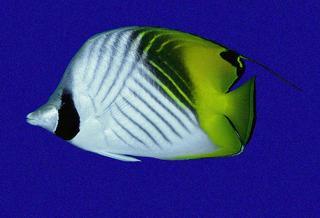
© Copyright Gerald Allen, 2006
· 0
Chaetodon auriga |
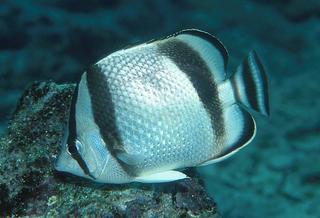
© Copyright Roger Steene, 2006
· 0
Chaetodon humeralis |
|
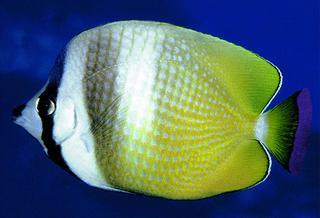
© Copyright Gerald Allen, 2006
· 0
Chaetodon kleinii |
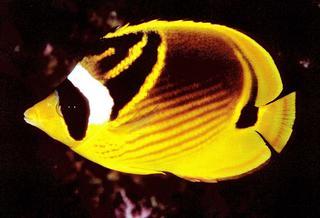
© Copyright John Rangall, 2006
· 0
Chaetodon lunula |
|
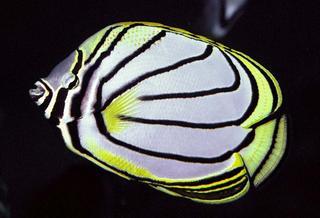
© Copyright Gerald Allen, 2006
· 0
Chaetodon meyeri |
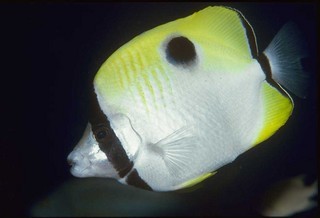
© Copyright Gerald Allen, 2006
· 0
Chaetodon unimaculatus |
|
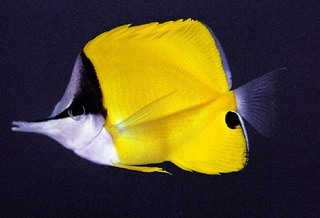
© Copyright Gerald Allen, 2006
· 0
Forcipiger |
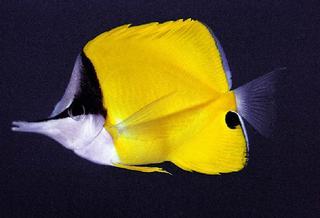
© Copyright Gerald Allen, 2006
· 0
Forcipiger flavissimus |
|
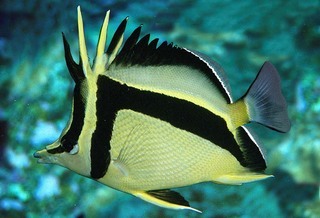
© Copyright Roger Steene, 2006
· 0
Prognathodes |
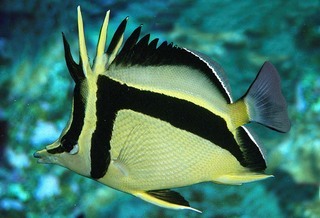
© Copyright Roger Steene, 2006
· 0
Prognathodes carlhubbsi |
|
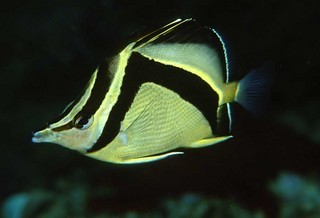
© Copyright Roger Steene, 2006
· 0
Prognathodes carlhubbsi |
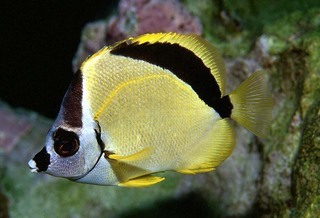
© Copyright Gerald Allen, 2006
· 0
Johnrandallia |
|
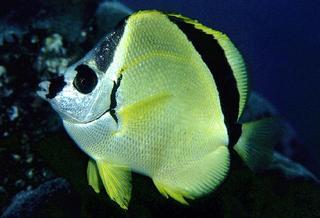
© Copyright Gerald Allen, 2006
· 0
Johnrandallia nigrirostris |
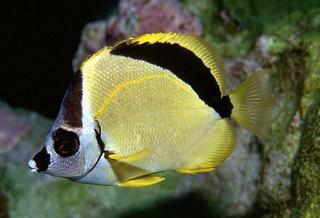
© Copyright Gerald Allen, 2006
· 0
Johnrandallia nigrirostris |
|
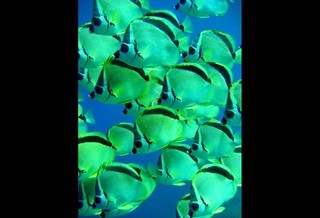
© Copyright Photographer/SFTEP, 2002
· 0
Johnrandallia nigrirostris |

© Copyright Gerald Allen, 2006
· 0
Chaetodontidae |
See
| | |
| | IDnature guides | |
| Overview |
Main identification features
- long concave snout
- body: deep, flat disc
- 1 d
- mouth small, protractile; small teeth
- preopercle without spine
FAMILY CHAETODONTIDAE
BUTTERFLYFISHES
Butterflyfishes are renowned for their striking color patterns, delicate shapes, and graceful swimming movements. They have deep, compressed bodies and small protractile mouths with brush-like teeth in the jaws. The scales are rough and cover the head, body, and median fins. There is a single dorsal fin with VI to XVI stout spines and no notch between the spiny and soft portions; the membranes between the front spines are deeply incised; the anal fin has III-V stout spines; there is a scaly "axillary process" at the upper base of the pelvic fins; the tail fin varies from rounded to slightly concave. These fishes have a distinctive late postlarval stage called a tholichthys which has large bony plates on the head and front body.
The family is worldwide and contains 10 genera and 124 species, which occur mainly in tropical seas around coral reefs. Only four species (three endemics and one Indo-Pacific) from four different genera are known to regularly occur in the tropical eastern Pacific, but four "vagrants" from the western Pacific (Chaetodon auriga, C. kleini, C. lunula, C. meyeri, and C unimaculatus) are infrequently encountered, particularly at the Galapagos.
Most species dwell in depths of less than 20m, but some are restricted to deeper sections of the reef, to at least 200m. Butterflyfishes are active during daylight and seek shelter close to the reef's surface at dusk. They often assume a drab nocturnal color pattern. Most species are restricted to a relatively small area of the reef, perhaps an isolated patch reef or part of a more extensive reef system. They travel extensively throughout their home range foraging for food. Many species feed on live coral polyps, others consume a mixed diet consisting of small benthic invertebrates and algae. A few species feed in midwater on zooplankton. Young butterflyfishes are highly prized as aquarium fishes. Most species grow to a maximum length that is under 30cm.
|
| References |
- Aburto-Oropeza , O. and Balart, E. F., 2001., Community structure of reef fish in several habitats of a rocky reef in the Gulf of California., Marine Ecology, 22:283-305.
- Acosta Salmón , H. and Martínez Fernández, E., 2000., Propuesta preliminar ... de concha nacar (Pteria sterna Gould, 1851) en la Bahía de la Paz, Baja California Sur, México. En Aburto Oropeza, O. y C. A. Sánchez Ortiz (Eds.). Recursos arrecifales del Golfo de California, …., Universidad Autónoma de Baja California Sur:95-106.
- Allen , G.R. and Robertson, D.R., 1997., An Annotated Checklist of the fishes of Clipperton Atoll, Tropical Eastern Pacific., Revista de Biologia Tropical, 45:813-843.
- Almenara Roldán, S. C., 2000., Demanda internacional en el manejo de especies marinas de ornato. En Aburto Oropeza, O. y C. A. Sánchez Ortiz (Eds.). Recursos arrecifales del Golfo de California, estrategias de manejo para las especies marinas de ornato., Universidad Autónoma de Baja California Sur:30-38.
- Bloch , M. E. and Schneider, J. G., 1801., M. E. Blochii, Systema Ichthyologiae iconibus cx illustratum. Post obitum auctoris opus inchoatum absolvit, correxit, interpolavit Jo. Gottlob Schneider, Saxo. Berolini. Sumtibus Austoris Impressum et Bibliopolio Sanderiano Commissum., Systema Ichthyol., :1-584.
- Bloch, M. E., 1787., Naturgeschichte der ausländischen Fische. Berlin., Naturg. Ausl. Fische, 3:1-146.
- Bloch, M. E., 1790., Naturgeschichte der ausländischen Fische. Berlin., Naturg. Ausl. Fische, 4:1-128.
- Breder, C.M. Jr., 1936., Scientific results of the second oceanographic expedition of the "Pawnee" 1926. Heterosomata to Pediculati from Panama to Lower California., Bull. Bingham Oceanogr. Collect. Yale Univ., 2(3):1-56.
- Béarez, P., 1996., Lista de los Peces Marinos del Ecuador Continental., Revista de Biologia Tropical, 44:731-741.
- Castri-Aguirre, J.L., Espinoza-Pérez, H. and Schmitter-Soto, J.J., 2002., Lista sitemática, biogeográfica y ecológica de la ictiofauna estuarino lagunar y vicaria de México. En: Lozano-Vilano, M. L. (Ed.). Libro Jubilar en Honor al Dr. Salvador Contreras Balderas., Universidad Autonoma de Nuevo León:117-142.
- Castro-Aguirre , J. L. , Balart , E. F. and Arvizu-Martínez, J., 1995., Contribución al conocimiento del origen y distribución de la ictiofauna del Golfo de California, México., Hidrobiologica, 5:57-78.
- Castro-Aguirre , J. L. and Balart, E. F., 1997., Contribución al conocimiento de la ictiofauna de fondos blandos y someros de la Ensenada de La Paz y Bahía de La Paz, B.C.S.. En Urbán Ramírez, J. y M. Ramírez Rodríguez (Eds.). La Bahía de La Paz investigación y conservación., Universidad Autónoma de Baja California Sur:139-150.
- Castro-Aguirre, J.L. and Balart, E.F., 2002., La ictiofauna de las islas Revillagigedos y sus relaciones zoogeograficas, con comentarios acerca de su origen y evolucion. En: Lozano-Vilano, M. L. (Ed.). Libro Jubilar en Honor al Dr. Salvador Contreras Balderas., Universidad Autonoma de Nuevo León:153-170.
- Castro-Aguirre, J.L., 1999., Ictiofauna estuarino-lagunar y vicaria de México., Editorial Limusa S.A. de C.V.: 1-629pp.
- Cuesta, T.C., 1932., Lista de los peces de las costas de la Baja California., Inst. Biol. Mexico, Anal, 3(1):75-80.
- De la Cruz , J. , Galvan , F. , Abitia , L. A. , Rodriguez , J. and Gutierrez, F. J., 1994., Lista sistematica de los peces marinos de Bahia Magdalena, Baja California Sur (Mexico). Systematic List of marine fishes from Bahia Magdalena, Baja California Sur (Mexico)., Ciencias Marinas, 20:17-31.
- Edgar, G.J. Banks, S., Fariña, J.M., Calvopiña, M. and Martínez, C., 2004., Regional biogeography of shallow reef fish and macro-invertebrate communities in the Galapagos archipelago., Journal of Biogeography, 31:1107-1124.
- Elorduy Garay , J. F. and Jiménez Gutiérrez, S. V., 2000., Metodologías para el estudio de los peces de arrecife. En Aburto Oropeza, O. y C. A. Sánchez Ortiz (Eds.). Recursos arrecifales del Golfo de California, estrategias de manejo para las especies marinas de ornato., Universidad Autónoma de Baja California Sur:72-82.
- Eschmeyer , W. N. , Herald , E. S. and Hamman, H., 1983., A field guide to Pacific coast fishes of North America from the Gulf of Alaska to Baja California. Peterson Field Guide Ser. 28., Houghton Mifflin:336pp.
- Findley, L.T., Hendrickx, M.E., Brusca, R.C., van der Heiden, A.M., Hastings, P.A., Torre, J., 2003., Diversidad de la Macrofauna Marina del Golfo de California, Mexico., CD-ROM versión 1.0. Projecto de la Macrofauna del Golfo . Derechos reservados de los autores y Conservación Internacional.
- Fischer , W. , Krup , F. , Schneider , W. , Sommer , C. , Carpenter , K. E. and Niem, V. H., 1995., Guia FAO para la Identificacion de Especies de para los fines de la Pesca. Pacifico Centro-Oriental. Volumen II. Vertebrados - Parte 1., FAO2:647-1200.
- Forsskål, P., 1775., Descriptiones animalium avium, amphibiorum, piscium, insectorum, vermium; quae in itinere orientali observavit... Post mortem auctoris edidit Carsten Niebuhr. Hauniae., Descr. Animalium, :1-164.
- Fowler, H.W., 1916., Cold-Blooded Vertebrates from Costa Rica and the Canal Zone., Proc. Acad. Nat. Sci. Phila., 68:389-414.
- Fowler, H.W., 1944., Results of the Fifth George Vanderbilt Expedition (1941) (Bahamas, Caribbean sea, Panama, Galapagos Archipelago and Mexican Pacific Islands). The Fishes., Acad. Nat. Sci. Philadel., Monographs, 6:57-529.
- Galván-Magaña, F., Abitia-Cárdenas, L.A., Rodríguez-Romero, J., Pérez-España, H., Chávez-Ramos, H., 1996., Systematics list of the fishes from Cerralvo island, Baja California Sur, Mexico., Ciencias Marinas, 22:295-311.
- Galván-Magaña, F., Gutiérrez-Sánchez, F., Abitia-Cárdenas, L.A., Rodríguez-Romero, J., 2000., The distribution and affinities of the shore fishes of the Baja California Sur lagoons. In Aquatic Ecosystems of Mexico: Status and Scope. Eds. M. Manuwar, S.G. Lawrence, I.F. Manuwar & D.F. Malley. Ecovision World Monograph Series., Backhuys Publishers:383-398.
- Garrison, G., 2000., Peces de la Isla del Coco., Instituto Nacional de Biodiversidad:393.
- Gill, T.N., 1862., Catalogue of the fishes of Lower California, in the Smithsonian Institution, collected by Mr. J. Xantus. Part 2., Proc. Acad. Nat. Sci. Phila., 14:242-246.
- Gotshall, D.W., 1996., Fishes of Rocas Alijos. In Rocas Alijos. Ed. R. W. Schmieder. Cornell Expeditions., Kluwer Academic Publishers: 347-354.
- Günther, A., 1860., Catalogue of the fishes in the British Museum. Catalogue of acanthopterygian fishes ... the British Museum. Squamipinnes, Cirrhitidae, Triglidae, Trachinidae, Sciaenidae, Polynemidae, Sphyraenidae, Trichiuridae, Scombridae, Carangidae, Xiphiidae., Brithish Museum (Natural History)2:1-548.
- Hildebrand, S.F., 1946., A descriptive catalog of the shore fishes of Peru., Bull. U.S. Nat. Mus., 189:1-530.
- Hooker, Y., 1998., Fauna asociada a las aguas cálidas presentes en la Bahía de Pucusana durante El Niño 1997-98, Junio a Julio de 1997., Instituto del Mar del Peru, Informe., 85:3-20.
- Hubbs , C.L.and Rechnitzer, A.B., 1958., A new fish, Chaetodon falcifer, from Guadalupe Island, Baja California, with notes on related species., Proc. Calif. Acad. Sci., 29(8):273-313.
- Humann, P., 1993., Reef Fish Identification: Galapagos., New World Publishing:192pp.
- Jimenez-Prado, P., Béarez, P., 2004., Peces marinos del Ecuador continental / Marine fishes of continental Ecuador., SIMBIOE/NAZCA/IFEA tomo 1 y 2.
- Jordan , D.S. and Evermann, B.W., 1898., The fishes of North and Middle America: a descriptive catalogue of the species of fish-like vertebrates found in the waters of North America, north of the Isthmus of Panama. Part II., Bull. U.S. Nat. Mus., 47:1241-2183.
- Jordan , D.S. and Gilbert, C.H., 1883., Catalogue of the fishes collected by Mr. John Xantus at Cape San Lucas, which are now in the United States National Museum, with descriptions of eight new species., Proc. U.S. Nat. Mus., 5(1882):353-371.
- Jordan , and McGregor,., 1898., List of fishes collected at the Revillagigedo archipelago and neighboring islands., Rept. U.S. Fisheries Comm., 24:271-284.
- Jordan, D.S., 1895., The fishes of Sinaloa., Proceedings of the California Academy of Sciences (Series 2), 5:377-514.
- Kendall , W.C. and Radcliffe, L., 1912., The shore fishes. Reports on the scientific results of the expedition to the eastern tropical Pacific, ... by the U.S. Fish Commission steamer ALBATROSS, from October, 1904, to March, 1905, Lieut. Commander L.M. Garret, U.S.N., Commanding. XXV., Mem. Mus. Comp. Zool., 35(3):75-171.
- Lacepède, B. G. E., 1802., Histoire naturelle des poissons., Histoire Naturelle Des Poissons, 4:i-xliv + 1-728.
- Lea, R.N. and Rosenblatt, R.H., 2000., Observations on fishes associated with the 1997-1998 El Niño off California., CalCOFL Rep., 41:117-129.
- Lopez , M. I. and Bussing, W. A., 1982., Lista provisional de los peces marinos de la Costa Rica., Revista de Biologia Tropical, 30(1):5-26.
- Love, M.S., Mecklenburg, C.W., Mecklenburg, T.A., Thorsteinson, L.K., 2005., es of the West Coast and Alaska: a checklist of North Pacific and Artic Ocena species from Baja California to the Alaska-Yukon border., U.S. Department of the Interior, U.S. Geological Survey, Biological Resources Division, 288pp.
- Madrid Vera , J. , Ruíz Luna , A. and Rosado Bravo, I., 1998., Peces de la plataforma continental de Michoacán y sus relaciones regionales en el Pacífico mexicano., Revista de Biologia Tropical, 42(2):267-276.
- McCosker , J.E. , Merlen , G. , Long , D.J. , Gilmore , R.G. and Villon, C., 1997., Deepslope fishes collected during the 1995 eruption of isla Fernandina, Galapagos., Charles Darwin Foundation, Noticias de Galápagos., 58:22-26.
- McCosker , J.E. and Humann, P.H., 1996., New records of Galápagos fishes., Charles Darwin Foundation, Noticias de Galápagos., 56:18-26.
- McCosker , J.E. and Rosenblatt, R.H., 1975., Fishes collected at Malpelo Island. In Graham, J.B. (ed.) The Biological Investigation of Malpelo Island, Colombia., Smithsonian Contrib. Zool., 176:91-93.
- McCosker, J.E., 1987., The fishes of the Galapagos Islands., Oceanus, 30:28-32.
- Meek , S.E. and Hildebrand, S.F., 1928., The marine fishes of Panama. Part III., Field Mus. Nat. Hist., Zool. Ser. Publ., XV:709-1045.
- Nalbant, T.T., 1995., The genus Prognathodes (Pisces: Chaetodontidae) in eastern Pacific Ocean (Baja California -- Galápagos) with a discussion on the phylogeny of the group., Trav. Mus. Hist. Nat. 'Grigore Antipa', 1995:497-526.
- Nelson, J.S., 1984., Fishes of the World (Third edition)., John Wiley and Sons:523pp.
- Orellana, J.J., 1985., Marine Fishes of Los Cóbanos: Fishes of El Salvador., Sigma Found:126pp.
- Phillips, P. C., 1981., Annotated Checklist of Fishes at Jiquilisco Bay, El Salvador., Revista de Biologia Tropical, 29:45-58.
- Pondella II, D.J., Gintert, B.E., Cobb, J.R., Allen, L.G., 2005., Biogeography of the nearshore rocky-reef fishes at the southern and Baja California islands., Journal of Biogeography, 32:187-201.
- Pérez-Mellado, J., Findley, LL. F., 1985., Evaluación de la ictiofauna acompañante del camarón capturado en las costas de Sonora y norte de Sinaloa, México. In Yáñez-Arancibia, A. (Ed.) Recursos pesqueros potenciales de México: La pesca acompañante del camarón., Universidad Nacional Autónoma de México: Cap. 5:201-254.
- Ricker, K.E., 1959., Fishes collected from the Revillagigedo Islands during the 1954-1958 cruises of the "Marijean."., Univ. Brit. Columbia Inst. Fish., Mus. Contrib., 4:10pp.
- Ricker, K.E., 1959., Mexican shore and pelagic fishes collected from Acapulco to Cape San Lucas during the 1957 cruise of the "Marijean"., Univ. Brit. Columbia Inst. Fish., Mus. Contrib., 3:18pp.
- Robertson , D.R. and Allen, G.A., 1996., Zoogeography of the shorefish fauna of Clipperton Atoll., Coral Reefs, 15:121-131.
- Rosenblatt , R.H. , McCosker , J.E. and Rubinoff, I., 1972., Indo-west Pacific fishes from the Gulf of Chiriqui, Panama., Contrib. Sci. Nat. Hist. Mus. Los Angeles Co., 234:18pp.
- Rubio , R. E. A. and Estupiñan, F., 1990., Ictiofauna del Parque Nacional Natural Sanquianga, un Analisis de su Estructura y Perspectivas para su Manejo., Memorias del VII Seminario Nacional de las Ciencias y Tecnologías del Mar. Comisión Colombiana de Oceanografía. Bogota, Colombia., :660-670.
- Rubio, E.A., 1986., Notas sobre la ictiofauna de la Isla de Gorgona, Colombia., Boletin Ecotropica. Univ. Bog. Jorge Tadeo Lozano, 13:86-112.
- Rubio, E.A., 1988., Estudio taxonomico de la ictiofauna acompañante del camaron en areas costeras del Pacifico de Colombia., Memorias del VI Seminario Nacional de las Ciencias del Mar. Comisión Colombiana de Oceanografía. Bogota, Colombia., :169-183.
- Smith , M. M. and Heemstra, P., 1986., Smith's Sea Fishes. Johannesburg: Macmillan South Africa. 1047 pp., Macmillan South Africa:1047pp.
- Snodgrass , R. E. and Heller, E., 1905., Papers from the Hopkins Stanford Galapagos expedition, 1898-1899. XVII. Shorefishes of the Revillagigedo, Clipperton, Cocos and Galapagos Island., Proc. Wash. Acad. Sci., 6:333-427.
- Sánchez Ortíz , C. , Arreola Robles , J. L. , Aburto Oropeza , O. and Cortés Hernández, M., 1997., Peces de arrecife en la región de La Paz, B.C.S.. En Urbán Ramírez, J. y M. Ramírez Rodríguez (Eds.). La Bahía de La Paz investigación y conservación., Universidad Autónoma de Baja California Sur:189-200.
- Thomson , D.A. , Findley , L.T. and Kerstitch, A.N., 2000., Reef fishes of the Sea of Cortez., University of Texas Press(Revised Ed.):353.
- Van der Heiden , A. M. and Findley, L. T., 1988., Lista de los peces marinos del sur de Sinaloa, México., Anales del Centro de Ciencias del Mar y Limnologia de la Universidad Autonoma Nacional de Mexico, 15:209-224.
- Vega, A.J., Villareal, N., 2003., Peces asociados a arrecifes y manglares en el Parque Nacional Coiba., Tecnociencia, 5:65-76.
- Villareal-Cavazos, A., Reyes-Bonilla, H., Bermúdez-Almada, B. and Arizpe-Covarrubias, O., 2000., Los peces del arrecife de Cabo Pulmo, Golfo de California, México: Lista sistemática y aspectos de abundancia y biogeografía., Rev. Biol. Trop., 48:413-424.
- Walker, B. W. and Baldwin, W. J., 1964., Provisional check list of fishes of the Revillagigedo islands., 18 pp.
|
| Acknowledgements | |
I thank Ashley MacDonald and John Pickering, University of Georgia, for technical support in building this page.
|
Top
Updated: 2024-09-21 00:55:36 gmt
© Designed by The Polistes Corporation
|
|